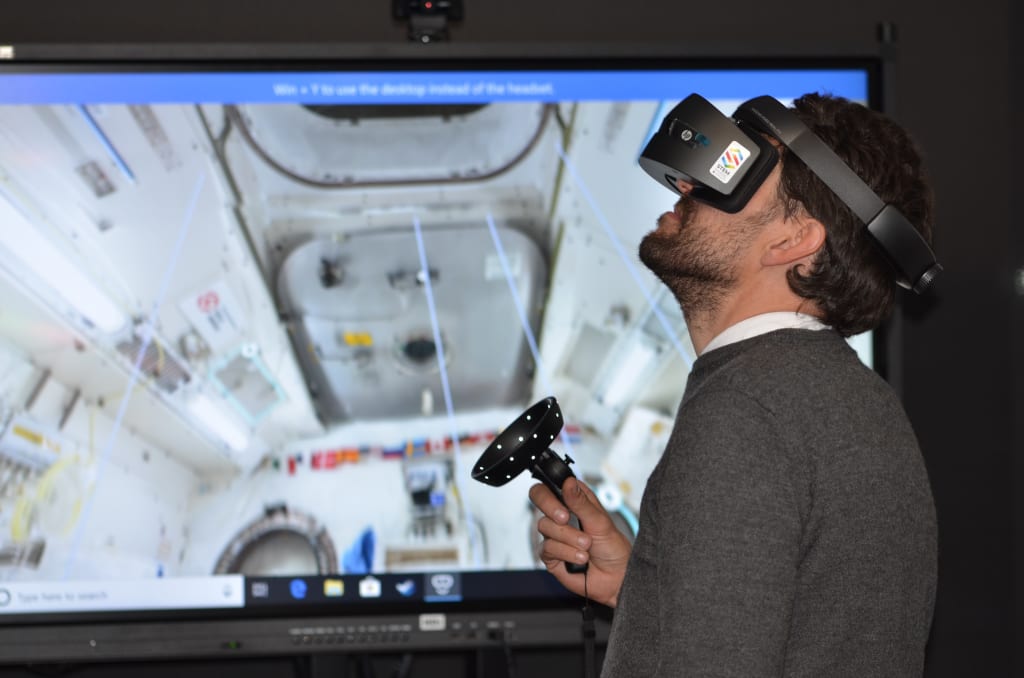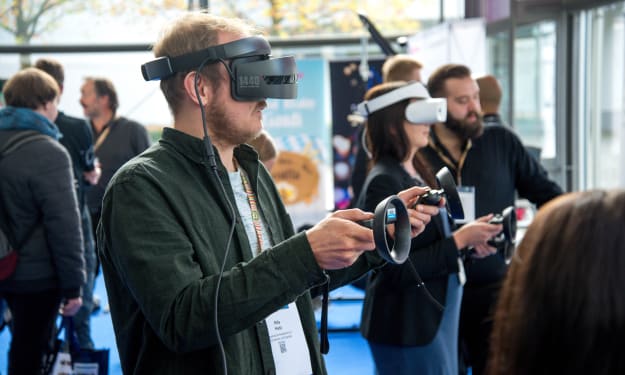5G & Reality Technologies
5G: A beacon of hope for AR & VR development

5G technology is being developed by many key companies in the telecommunication industry like AT&T and Verizon. This technology promises an unprecedented upgrade in the way we will interact with our smart devices. As interesting as that promise might seem, it is not the one we should be focusing on.
The true change that 5G will be bringing is in the field connectivity and development. Commercialized technologies such as Artificial Intelligence and the Internet of Things and Industrial Internet of Things will reach their full potential once 5G technology is going to be up and running. But, we might have to wait and see how this will end up working.
But, there is an aspect in technology development that is going to be revolutionized thanks to 5G. That aspect is Augmented Reality and Virtual Reality Development. Both AR and VR are, to a certain extent, immersive technologies that require a stable network connection to allow the immersion experience to be as realistic and smooth as possible.
With an internet connection said to be n times faster than the one we currently have using 4G LTE, 5G will definitely deliver in terms of network connection stability.
Hence, 5G technology should be bringing a wave of revolution for Augmented Reality and Virtual Reality developers. 5G is going to be crucial for AR and VR technologies in the future.
5G and Decreasing Latency
One thing that has stopped us from fully embracing the true potential of Augmented Reality and Virtual reality is a ubiquitous stable network connection. Without such a feature, VR and AR can still be implemented and used; however, both technologies will still have the network stability problem.
5G, which is the next generation of wireless communication technology, inherently brings aspects such as high-speed, ultra-low latency and high bandwidth all in a wireless communication network. Accordingly, the initial implementations of AR applications in the consumer and at the enterprise level will become seamless once 5G networks become widespread.
But, how would this happen?
Latency means the time lag between a request and the response which mainly refers to how fast a response is. However, it is expected that 5G will bring about a 10 times decrease in latency time. 5G technology will also improve the time it takes to send the requested data. This means you can expect the loading time to be completely low i.e. a 3-gigabyte movie can be downloaded in less than 4 seconds!
This is crucial for the UX of both Augmented Reality and Virtual Reality. According to Next Gen Apps, one of the benefits of Augmented Reality is increasing conversion and reducing the cognitive load of the user which cannot be achieved with a user experience constantly disturbed by latency.
While the impact of reduced latency on download speed is straightforward, its impact on the development of Virtual Reality development is not quite so.
In VR, users will have an unpleasant experience when the latency is over 20 ms. With 5G, latency is expected to be under 2 ms. Ergo, the user experience will be amazing. In other words, it will be smooth and natural. As VR is essentially an immersive technology, this is incredibly important. Along with an amazing UX design, AR and VR’s potential in the different industries will be fully exploited.
Improved Connectivity
It is common knowledge that Augmented Reality and Virtual Reality applications are immensely sensitive to the performance of a network, with interruptions, as slight as they may be, having a considerable negative impact on the UX.
Our current 4G networks provide thousands of connections for each cell, yet they still cannot meet our needs. This is a sad truth for our current needs and especially our future ones. But, with 5G, this is set to change, drastically too. According to the data published by Huawei, a 5G network provides up to a million connections per square kilometer.
Billions of connections are needed for new tech such as wearable, smart, connected technology devices. And, the more devices there are on the network, the more they will create a need for more connections, which is something we cannot do with the technology on the market right now.
This is where 5G technology comes in.
When 5G will be released, it will enable the following:
- Faster Data Speed
- Data Congestion
- New Endpoints
With all these elements, Augmented Reality and Virtual Reality apps will be able to run without lagging or interference or disruptions.
Ubiquitous Access to Apps
Currently, many of the VR head-mounted displays require a powerful PC so you can make them run. The arrival of 5G will change that for good. Instead of limiting yourself to a certain location where there is a powerful computer, 5G technology will redirect the storage, power consumption, and processing power into the cloud. This means that VR technology can be accessed at any time, anywhere.
However, it is worth mentioning that the growth of Augmented Reality and Virtual Reality in this direction is solely meant for commercial gaming rather than the enterprise level.
Increased Traffic
As it has been repeatedly mentioned, 5G will signal numerous and diverse new devices that will alter the way we interact with technology for millions of users. Nonetheless, to achieve such a jaw-dropping feature, a strong connection is required, and that’s what 5G is going to provide. As stated by Qualcomm, 5G will introduce a huge upgrade in terms of traffic capacity, which is expected to be 100 times larger than the traffic capacity obtained with the 4G connection. For both businesses and individuals to enjoy the advantages of Virtual Reality and Augmented Reality on a daily basis, increased traffic is a must. This is quite evident. A network that is overflooded with traffic will create latency, which is a problem Virtual Reality and Augmented Reality cannot cope with.
Monetization of Augmented Reality
It goes without saying that the following part about monetization refers to the monetization of AR apps. As the main Augmented Reality venue, for now, is mobile and tablet apps, it makes a lot of sense to consider apps as the principal source of monetization.
E-commerce
One can say that e-commerce and augmented reality are the best mixes to ever exist. Essentially, thanks to its power to superimpose objects into perceived reality, AR can help customers see different products like tables, chairs, TVs, sneakers, etc. in real life before making the decision to purchase them. A more interesting feature, besides product testing, would be the ability to purchase them on the app. In-app purchase is a huge trend in mobile app development. Whether these products are yours, such as Ikea’s AR app, or can be purchased on other’s websites (affiliate program), a one-click purchase would be a complementary strategy to your app’s AR characteristics.
Freemiums
Freemiums are the most classical business revenue model. As the name suggests, a freemium offers a certain free aspect to the users to get them hooked on the functionalities of the app, so they can, later on, convert easily. To bring the discussion back to Augmented Reality, you need to make sure that the AR feature you are offering is riveting, and solves a problem for the user. And knowing the exclusiveness of AR, hooking the user on is quite the easy part. What rests on your shoulder is providing the users with an app that solves (one or more) their problems.
These are not the only business models that one can use to monetize an AR integrated app, however, they are the most commonly used. We invite you to come up with your own model and do a lot of testing.
Monetization of Virtual Reality:
Virtual Reality has more potential in terms of monetization, as it is more present in the world of mobile apps.
Freemiums:
Freemium monetization strategy is ubiquitous when the application distributes digital content directly to users. This pricing strategy implies an approach in which the application can be downloaded for free, but the money is charged for additional services or features that extend the app’s functionality.
This model will likely bring you some profit, especially at an early stage, or when you first enter the market. Moreover, most VR apps can be developed as cross-platform apps, which are significantly cost-effective, and make the VR experience available for a broader audience.
In-App Purchases
As the most effective business monetization strategy, in-app purchases are immensely adopted in the virtual reality world. For example, there's Public Speaking VR, a company that uses VR to train people in public speaking and helps them acquire presentation skills.
As most would guess, certain features of training are free, but the more advanced ones would require payment so the user can access them. When implementing this strategy, it is important to think about whether your company would like to offer a subscription model or target individual purchases.
Product Placement
As more people are taking advantage of virtual reality apps and their features, advertising on this platform is becoming a wise decision to be considered for monetization. Product placement is an emerging solution that offers to replace pop-up commercials, which are a source of nuisance and distraction for the users.
This monetization model is interesting because of two main reasons. Firstly, it helps brands in their narratives, which is exactly what consumers love most. For instance, brands will be able to show their customers how to use their product, how to benefit from it. Second, it will help developers spread more of the free content instead of a paid one, supported by advertising revenue.
Conclusion
For AR and VR to become a reality for the world, the lack of suitable supporting network needs to be addressed at once. With the rise of 5G technology, Augmented Reality and Virtual Reality are starting to sound like more than just futuristic technologies. With its faster data rates, lower cost per bit and almost a non-existent latency, the users are guaranteed to have a better screen quality, traffic capacity, and immersive experience. 5G will be bringing rise to the next level of immersive technology and cloud-based services experiences, but it needs to be adopted first.
About the Creator
Aziz Dhaouadi
Knowledge is meant to be shared not kept hidden.






Comments
There are no comments for this story
Be the first to respond and start the conversation.